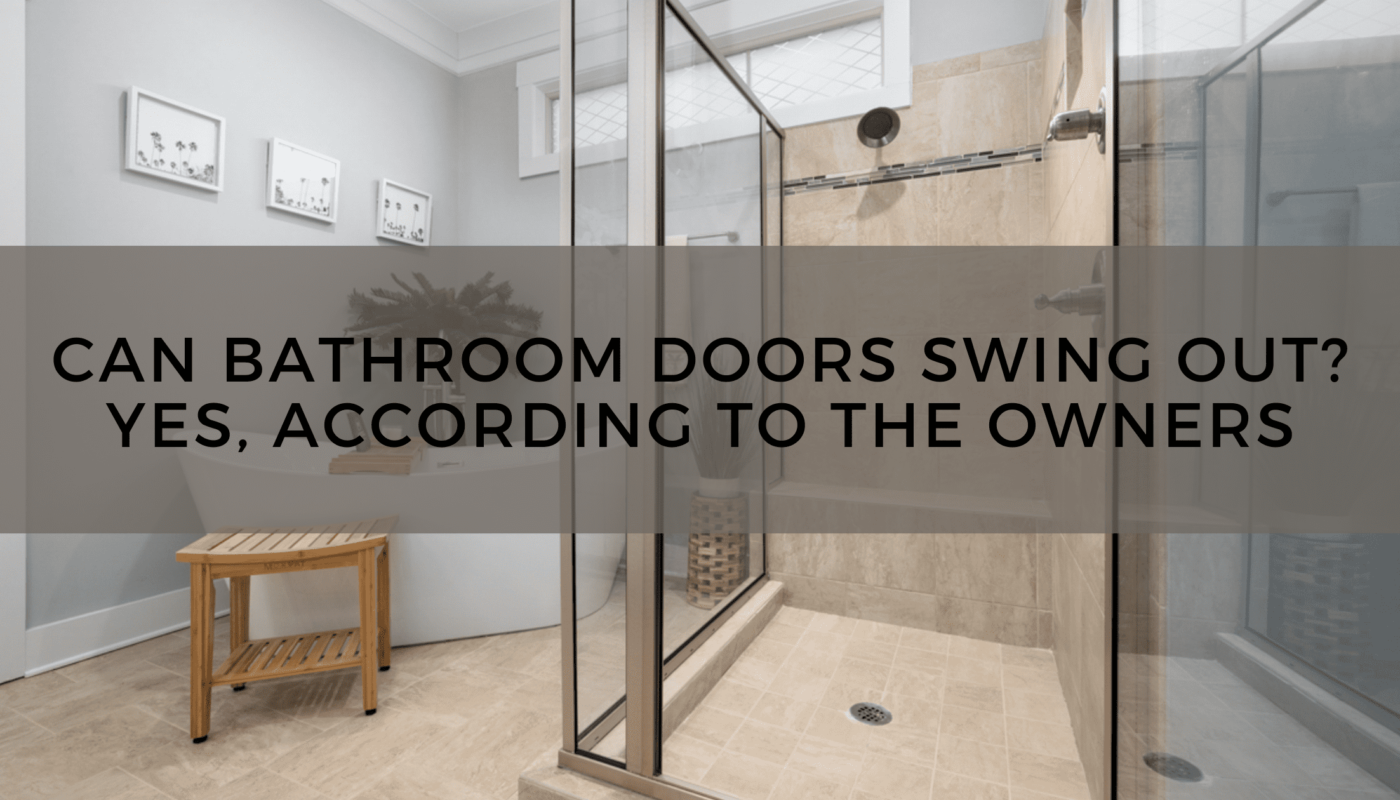Table of Contents
Introduction
Bathroom doors, often overlooked in the grand scheme of home design, play a crucial role in ensuring privacy and functionality within a living space. The dynamics of these doors go beyond mere entry and exit points; they involve thoughtful considerations, such as the direction in which they swing. In this section, we’ll delve into the basic definition of bathroom doors and shed light on the importance of their swing direction.
Now, let’s explore why the direction in which a bathroom door swings holds significance. The door swing direction refers to whether the door opens inward or outward, and this seemingly small detail can have a considerable impact on the overall usability and design of a bathroom. The choice of door swing direction is influenced by practical considerations, safety concerns, and adherence to building codes.
For instance, understanding the importance of door swing direction involves considering factors like available space within the bathroom. In smaller bathrooms, an outward-swinging door might be preferred to maximize interior space. Accessibility is another critical aspect, especially for those with mobility challenges, where the ease of entry and exit becomes a paramount concern.
In emergency situations, the door swing direction can be a crucial safety consideration. An outward-swinging door allows for a quicker and unobstructed exit, potentially making a significant difference in urgent scenarios.
Advantages of Bathroom Doors Swinging Outward
Space-saving:Can Bathroom Doors Swing Out
One of the primary advantages of having bathroom doors swing outward is the efficient utilization of space. In smaller bathrooms where space is at a premium, an outward-swinging door allows for better optimization of the available area. Unlike inward-swinging doors that require clearance within the bathroom, outward-swinging doors utilize the hallway or adjacent space, maximizing the use of the entire room.
Accessibility:
Another significant benefit is enhanced accessibility. Outward-swinging doors facilitate easier entry and exit, making the bathroom more user-friendly, especially for individuals with mobility challenges. The outward swing provides a wider opening, reducing potential obstacles and creating a more accommodating environment for everyone, including those using mobility aids such as walkers or wheelchairs.
Safety and Emergency Situations:Can Bathroom Doors Swing Out
The outward swing of bathroom doors becomes particularly crucial in safety and emergency situations. In cases of medical emergencies or accidents within the bathroom, an outward-swinging door allows for quick and unobstructed access for first responders or individuals providing assistance. This swift access can be critical in situations where every moment counts, potentially preventing further injury or damage.
Disadvantages of Bathroom Doors Swinging Outward
Limited Space Inside:Can Bathroom Doors Swing Out
One notable disadvantage of bathroom doors swinging outward is the potential limitation of space within the bathroom itself. In contrast to inward-swinging doors that use the interior space for clearance, outward-swinging doors encroach upon the external area. In smaller bathrooms, this can create challenges as the door may impede movement or access to other fixtures when open. The limited space inside can be a practical concern, especially in bathrooms where every inch of space is valuable.
Aesthetics and Design Considerations:
The aesthetics of a living space are pivotal to creating a visually pleasing environment. Outward-swinging doors, while functional, may not align with certain design preferences. Homeowners often prioritize a seamless and harmonious interior, and the swinging direction of a door can impact the overall aesthetic appeal.Can Bathroom Doors Swing Out Design considerations become crucial, especially when the bathroom is a focal point of the home. The outward swing might disrupt the desired flow or visual balance intended for the space.
Building Codes and Regulations
Building Code Requirements:
Building codes are a set of regulations established by local authorities to ensure the safety, structural integrity, and overall well-being of occupants in a building. Can Bathroom Doors Swing OutWhen it comes to bathroom doors, building codes often dictate specific requirements regarding their installation and operation. These codes may address aspects such as the door’s dimensions, materials, and, importantly, the direction in which it should swing. Compliance with building code requirements is essential during construction or renovation to meet the standards set forth by the jurisdiction.
Accessibility Standards:
Accessibility standards, often integrated into building codes, focus on creating inclusive spaces that cater to individuals with diverse abilities. In the context of bathroom doors, accessibility standards address features that promote ease of use for everyone, including those with disabilities. This encompasses considerations such as door width, height, and, crucially, the direction of door swing. For instance, the Americans with Disabilities Act (ADA) in the United States provides guidelines to ensure that doors, including those in bathrooms, are accessible to individuals with mobility challenges. These standards aim to eliminate barriers and enhance the overall usability of spaces.
Choosing the Right Door Swing Direction
Consideration of Available Space:Can Bathroom Doors Swing Out
The choice of the door swing direction is significantly influenced by the available space in the bathroom. In smaller bathrooms where space is limited, opting for an outward-swinging door can be a practical decision. This allows for more efficient use of the interior space, preventing potential obstructions and providing a more open and accessible environment. Conversely, in larger bathrooms with ample space, the luxury of an inward-swinging door may be feasible without compromising functionality.
Personal Preferences:
Personal preferences play a crucial role in the decision-making process. The direction in which a bathroom door swings can impact the overall flow and feel of the space. Can Bathroom Doors Swing OutSome individuals may have a strong preference for the visual aesthetics of an inward-swinging door, appreciating the seamless look it can offer. Others may prioritize the practicality of an outward-swinging door, valuing the added space and accessibility it provides. Considering personal preferences ensures that the chosen door swing direction aligns with the homeowner’s unique taste and style.
Safety Concerns:
Safety considerations are paramount when choosing the door swing direction, particularly in households with elderly individuals, children, or individuals with mobility challenges. Outward-swinging doors can enhance safety in emergency situations, allowing for quick and unobstructed exits.Can Bathroom Doors Swing Out On the other hand, inward-swinging doors may be preferred in spaces where the risk of the door colliding with a person or object outside the bathroom is a concern. Balancing safety considerations ensures that the chosen door swing direction prioritizes the well-being of occupants.
DIY Tips for Changing Door Swing Direction
Changing the swing direction of a bathroom door is a manageable do-it-yourself (DIY) project that can enhance functionality and better suit the layout of your space.Can Bathroom Doors Swing Out Here’s a guide on the tools needed and a step-by-step process to help you successfully modify the door swing direction:
Tools Needed:
Before starting the project, gather the necessary tools:
- Screwdriver or power drill
- Hammer
- Chisel
- Wood filler
- Sandpaper
- Measuring tape
- Pencil
- Hacksaw (if resizing the door)
- Door hinges (if not reusable)
Step-by-Step Guide:
Remove the Door: Begin by taking the door off its hinges. Use a screwdriver or power drill to unscrew the hinges from the door frame. Ensure that the door is safely removed to facilitate easier adjustments.
Determine New Hinge Locations: Assess the new location for the hinges on the opposite side of the door frame. Use a measuring tape and pencil to mark the positions. Ensure accuracy to avoid misalignments.
Chisel Out Hinge Mortises: Use a chisel to create mortises for the hinges. Carefully remove enough wood to accommodate the hinges flush with the door and frame. Take your time to achieve a precise fit.
Resize the Door (if necessary): If the door needs resizing to fit the new opening, use a hacksaw to trim it accordingly. Ensure an even cut to maintain a professional appearance.
Attach Hinges to Door: Affix the hinges to the door using the screws provided. Ensure they are securely fastened to prevent any wobbling or misalignment.
Attach Hinges to Frame: Secure the hinges to the new locations on the door frame. Again, use the appropriate screws and ensure a tight fit.
Test the Door: Reattach the door to the frame and test its swing. Ensure smooth operation and that it closes securely. Make any necessary adjustments to the hinges if needed.
Fill and Sand Hinge Cutouts (if needed): If the old hinge cutouts are visible, use wood filler to cover them. Once dry, sand the filled areas to create a smooth surface.
Apply Finish (if desired): If the door has been resized or if any exposed wood is visible, consider applying a finish that matches the existing door. This step adds a professional touch to the modification.
Final Adjustments: Make any final adjustments to ensure the door swings smoothly and aligns properly with the frame.
Professional Assistance
When contemplating changes to the swing direction of a bathroom door, there are instances where seeking professional help becomes advisable.Can Bathroom Doors Swing Out Understanding when to enlist the services of a contractor or carpenter is crucial for ensuring a seamless and well-executed modification. Here’s an explanation of when professional assistance is recommended and the benefits of hiring a skilled professional:
When to Seek Professional Help:
Structural Changes: If the modification involves structural changes to the door frame, wall, or surrounding structure, it’s advisable to seek professional assistance. This is especially true if the alteration goes beyond a straightforward hinge adjustment or if it requires expertise in carpentry and construction.
Complex Installations: When the modification involves complex installations, such as converting a door from swinging inward to outward, professional help is recommended.Can Bathroom Doors Swing Out This ensures that the changes comply with building codes, safety standards, and that the structural integrity of the door and frame is maintained.
Lack of DIY Experience: If you lack experience in DIY projects or carpentry, it’s wise to consult a professional. They bring expertise and precision to the task, reducing the risk of errors and ensuring a high-quality result.
Hiring a Contractor or Carpenter:
Expertise in Construction: Contractors and carpenters possess the necessary expertise in construction and woodworking. They understand the intricacies of modifying door swing directions, ensuring that the changes align with industry standards and safety regulations.
Efficiency and Precision: Professionals are equipped with the right tools and skills to execute the modification efficiently and with precision. This often results in a quicker turnaround time and a finished product that meets or exceeds expectations.
Compliance with Codes: Building codes and regulations are vital considerations in door modifications. Professionals are well-versed in these codes, ensuring that the changes adhere to legal requirements and safety standards.
Problem Solving: If unexpected challenges arise during the modification process, professionals can effectively problem-solve and adapt to ensure a successful outcome. Their experience allows them to navigate complexities that may arise during the project.
Warranty and Guarantee: Hiring a professional often comes with the added benefit of a warranty or guarantee on their work. This provides assurance that any issues arising from the modification will be addressed, offering peace of mind for the homeowner.
Conclusion
In conclusion, the decision on whether bathroom doors should swing inward or outward is a multifaceted one, influenced by various factors. Understanding the advantages and disadvantages of each swing direction is pivotal in making an informed choice that aligns with both practical needs and personal preferences.
For those considering a change in door swing direction, the DIY route can be a viable option, offering the satisfaction of a hands-on project. The provided step-by-step guide and list of tools aim to empower homeowners to undertake the modification confidently.Can Bathroom Doors Swing Out However, it’s crucial to recognize when professional assistance is warranted. Structural changes, complex installations, and the absence of DIY experience are clear indicators that the expertise of a contractor or carpenter is the prudent choice.
Ultimately, the goal is to create a bathroom space that is not only functional but also harmonizes with the aesthetic vision of the homeowner. Whether opting for a DIY approach or seeking professional help, the key is to strike a balance between practical considerations, safety concerns, and personal preferences.




